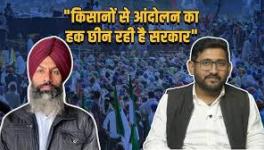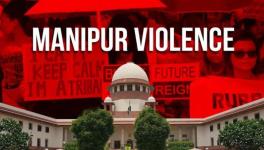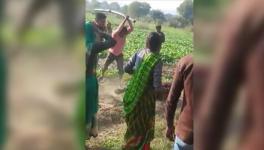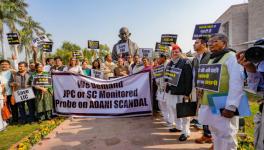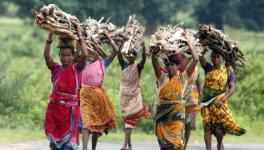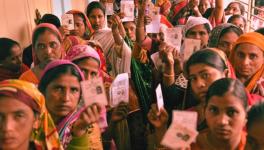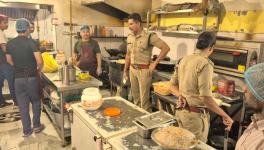On The Campaign Trail: Lucknow To Ayodhya To Barabanki
As we drive into Lucknow city, a large public television screen greets us with the “UP ko ye saath pasand hai” jingle, with shots of Uttar Pradesh Chief Minister Akhilesh Yadav reminding the viewer of the key figure in the Samajwadi Party’s battle for power. Elsewhere, posters and hoardings of the Bharatiya Janata Party and Bahujan Samaj Party, provide the setting for a state currently in the midst of a complicated and important election -- one that is sure to set the tone for the next General Elections in 2019.
We begin our journey into this part of UP with a quick visit to the party offices. While each office has a flurry of activity, it is the Congress party office that stands out, as party workers hand out flags and other paraphernalia. The Congress’ alliance with the Samajwadi party has brought the party back into action, with the SP benefitting in turn through a consolidation of the Muslim vote that seems to have translated on the ground. We chat with Congress politician Ashok Gehlot on the prospects. “All is well,” he tells us. “The alliance is bound to win.”
Nearby, at the Samajwadi party office, the mood is a lot quieter. A lone poster of Mulayam Singh Yadav marks off the two sections of the office, with the other being Akhilesh Yadav’s side. We decide to spend the day trailing Akhilesh Yadav, and make our way to the Malihabad assembly seat where Akhilesh is to hold a rally.
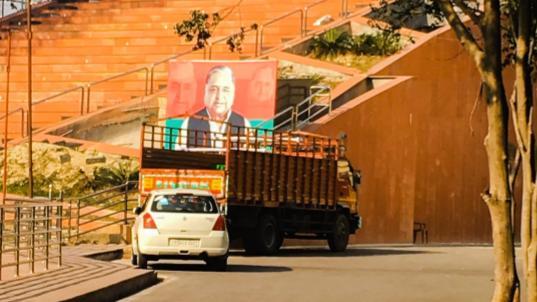
Elections in India often have an anti-incumbency factor, and the Samajwadi Party’s commanding 224 hold over the current Assembly is the target of that factor. “This election is different,” a Faizabad based journalist later tells us. “The anti-incumbency factor that is most certainly there has been effectively directed toward Mulayam following the internal family fight in the Samajwadi Party. Akhilesh has emerged with a clean chit.” Whether that’s enough to retain the 29% vote share the SP received in the 2012 elections remains a question no one can yet answer.
Analysis aside, the mood at Akhilesh Yadav’s rally in Malihabad is infectious. Chants of “Jiska UP uska desh (who wins UP, wins the nation)” reverberate as we make our way through the crowds to the front. The chanting and sloganeering grows louder as Akhilesh Yadav’s helicopter descends and the young CM makes his way to the stage. The crux of his speech focuses on the work the ruling party has done in the last five years. “We have provided ambulances, distributed laptops, upped pensions, built roads, facilitated mandis…” Akhilesh says. “Kaam kiya hai, kaam kiya hai,” the crowd chants. The Chief Minister then takes a hit at BSP leader Mayawati. “Meri bua kabhi bhi rakshabandhan bana sakti hai BJP ke saath (my aunt can form an alliance with the BJP at any time)” he says, clearly pandering to the local Muslim’s primary concern this election. He moves on to the BJP, urging the crowd not to believe any of the party’s promises.
Toward the end of his speech, Akhilesh notices The Citizen team in the front, and pulls us out. We rush to meet him at his helicopter, and quickly interview him, focusing on the alliance, its prospects for 2019, the internal SP fight, and deliverables for the development of the state.
The next day, we drive toward the religious city of Ayodhya, stopping at various points along the way. We immediately notice a stark difference in the reaction of the people, in comparison to an earlier visit to western UP. A couple of weeks before the first phase of polling, we had travelled to Muzaffarnagar through Meerut, and the people in the area were outspoken and visibly opinionated about the upcoming polls. The communalisation efforts of the BJP didn’t seem to be working, with Jats angry with the party for failing to deliver on previous promises. Most Jats said they would be voting for Ajit Singh. In riot torn Muzaffarnagar, Muslims and Jats stood side by side, with the Samajwadi Party having the clear edge as the politics played out.
Fast forward a few weeks to our journey through central and eastern UP, and the mood was entirely different. Efforts to engage people in a conversation on the elections yielded lacklustre results, and although many spoke about whom they were supporting, the excitement that usually accompanies election season was clearly lacking. “There are several reasons for this,” a party worker who spoke to us anonymously explained. “The Muslim is quiet because he doesn’t want the vote to become polarised, while the Hindu who had come out in huge numbers for the BJP in 2014 is less enthusiastic because the party did not deliver on several promises. There is the added impact of demonetisation; although many won’t admit the impact notebandhi has had, inside they are suffering.”
To us, the impact of demonetisation is obvious. In Ayodhya, the tiny bazaar streets that used to be jampacked with pilgrims and visitors are entirely empty, with not a single customer at any of the shops. Although the sitting MLA in the area is from the Samajwadi Party, the seat is a BJP stronghold, with the lotus holding sway for years before the SP managed an upset. Most of the shopkeepers in the area are vocal in their support for the BJP, but there is no indication of a wave of any kind. When asked about demonetisation, most dismiss its impact, saying that they have not been affected in the least.
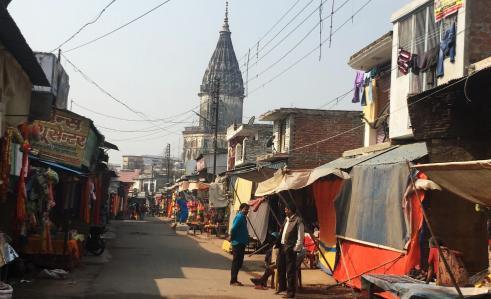
It’s only as we move further in that a different narrative emerges. “The area has been empty since demonetisation,” a shopkeeper, Ram Bhushan Yadav, selling small idols and sweets tells us. “Mornings are usually the busiest time, but now, even if people come, they don’t buy anything.” From here, more and more people echo a similar sentiment. “People don’t come like they used to,” a young man in a bangle shop tells us. “Notebandhi has finished us,” says Mukesh Kumar who runs a mithai shop.
We realise that although demonetisation has adversely impacted most lives in the region, it hasn’t entirely swung the loyal BJP vote. It has, however, compromised the enthusiasm amongst the BJP voter, the consequence of which is that ‘Brand Modi’ too has taken a bit of a hit.
In a bid to better understand the trends, we decide to visit veteran journalist Sheetla Singh in nearby Faizabad. Singh is the editor of local daily paper Jan Morcha, which was set up as a cooperative in 1958 following the recommendations of the First Press Commission report that identified monopoly capital as the biggest threat to freedom of speech. “The problem is that every observer of this election is viewing it through the brand of glasses that they choose to wear,” Singh tell us, as the paper’s reporters gather around and join in.
“It’s largely between SP and BSP,” says journalist KP Singh. “The BJP themselves admit that the 2014-kind of win cannot be repeated this time around.” “Internal party politics within the BJP is also a factor. Notebandhi has been dropped as an electoral campaign, and whereas the UP branch of the BJP campaigned on building the Ram Mandir, the Prime Minister has remained silent on that issue. He didn’t even visit Ayodhya. People are also upset that the ‘chamatkar’ the BJP promised never materialised. And the BJP has no local face; there is no Chief Minister candidate.”
“On the other hand, there are two things that have benefited the SP,” he continues. “One is the consolidation of the Muslim vote, as the Muslim has no guarantee that Mayawati won’t align with the BJP if need be. The Muslim will vote for the SP because of lack of options. The other is that following the family feud, Akhilesh has emerged bigger than the party. All the sins of the past five years have been seemingly absolved, as no one is talking about the poor performance of the party while it was in power.”
An important local politician who spoke to us on the condition of anonymity echoed a similar line of reasoning. “One of the biggest challenges faced by the BJP is its lack of weight in terms of the candidates. In Ayodhya for instance, the BJP candidate previously fought on both SP and BSP tickets. Same in Bikapur -- the candidate was given a ticket after being in the party for only three months. There is a vacuum in the BJP.”
What does this mean for the BJP vote? “The vote loyal to the BJP is still intact, but there is no wave in favour of any party. While the BJP is impacted by the above, the SP is affected by a sentiment against all sitting MLAs (224 sitting MLAs are SP). And Mayawati hasn’t been able to consolidate the Dalit-Muslim vote bank that she was hoping to. While the Dalit vote is behind her, the Muslim is not.”
Nevertheless, it’s advantage SP in Faizabad. Currently, 4 of 5 seats in this district are SP, and one is BJP. In this election, the SP has a good chance in all five seats, with the BJP putting up a fight in Ayodhya and Rudauli, and the BSP in the fray in Gosaiganj, Milkipur and Bikapur.
In nearby Barabanki district, the story is similar, as currently the SP has all five assembly seats, we are told. We make our way to Prime Minister Narendra Modi’s rally in Barabanki, where a large crowd has gathered. As we stand along the highway and listen, I am reminded of one of the very first slogans that I heard in this part of UP: “Jiska UP uska desh.” Over half way into polling, and no one can say who will win that very coveted title.
Disclaimer: The views expressed here are the author's personal views, and do not necessarily represent the views of Newsclick.
Get the latest reports & analysis with people's perspective on Protests, movements & deep analytical videos, discussions of the current affairs in your Telegram app. Subscribe to NewsClick's Telegram channel & get Real-Time updates on stories, as they get published on our website.









